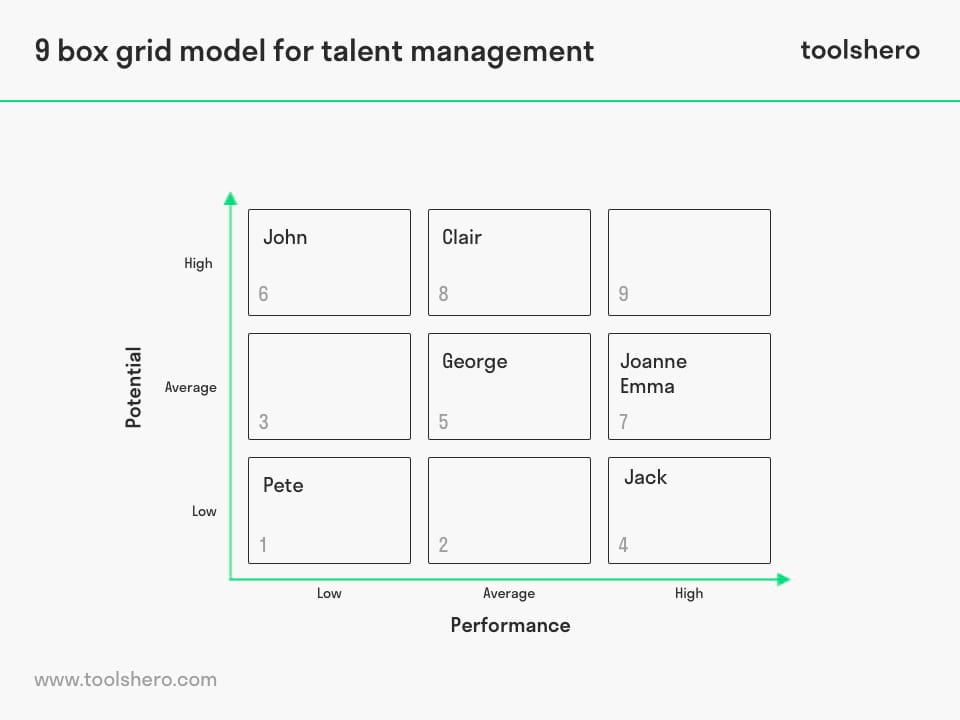9 Box Grid explained

9 Box Grid model: this article explains the 9 Box Grid in a practical way. Next to What is this human resources tool this article also highlights the Nine Boxes of the 9 box grid model including an example overview, the importance of follow up and a 9 Box Grid template to get started. Enjoy reading!
What is the 9 Box Grid for Talent Management?
The 9 Box Grid for Talent Management is a tool designed for assessing potential in team members, assessing employee performance, and performance of leadership teams. It is also used to reveal the talents and succession planning of employees.
In addition, it offers ways to better monitor these talents and develop them further. It is an instrument that can be used for team and talent management, talent development and talent spotting.
Team development becomes more transparent and supervisors will gain valuable information about their employees’ strengths. They can use this information to deploy different leadership roles. The 9 box grid model received international recognition thanks to Jack Welch, the CEO of the American company General Electric.
He emphasised increasing employee performance. He does so by recruiting the right people and committing the best employees to the company. In practice, it means that some employees have to be let go because they do not add value or are not a good fit for the organisation.
Nine Boxes of the 9 box grid model including an example overview
The definitions
The 9 box grid is formed by a grid with two axes. The x-axis shows the employee’s ‘performance’, which can be ‘low’, ‘average / normal’, and ‘high’. The y-axis shows the ‘potential’, which comes down to the ability to further develop the talents of individual employees. This factor can also be ‘low’, ‘average / normal’, and ‘high’.
Together, these combinations form nine different boxes, each with their own characteristics. You can then enter names of individual employees into the grid. The 9 box grid model makes it possible to see the value of each staff member at a single glance.

Figure 1 – example overview of the 9 box Grid of a team
In most cases, the manager decides in which box of the model employees should be placed, based on the performance reviews.
The employee’s performance, the supervisor’s experience with that employee, and his or her estimate of the employee’s (growth and performance managers) potential all decide how the 9 box grid model is filled out. A supervisor can use a pen to write down the employee names, but using Post-It notes is often easier.
That way, names can easily be moved, and the box in which an employee is placed is not permanent. By making it a team activity, it can lead to interesting discussions about what ‘performance’ and ‘potential’ mean exactly and how they can be seen in the work people carry out.
The 9 boxes each have their own characteristics, which have been briefly described below:
Box 1: Low performance / Low potential
Within the 9 box grid, this is the box for the so-called underperformers. In their work and performance, they do not meet the requirements set by the organisation, meaning they are not suitable for their current position.
There is a termination risk for the employment contract, as organisations want to employ as few underperformers as possible. It is possible that the employee is in a role that is completely wrong for them and is overwhelmed by their responsibilities.
In such cases, it is a good idea to look at the employee’s current position together and look at what role would better suit them. If there is a vacancy that matches that, it is always a good idea to give that a try.
If there is no other option, then letting them go will be the best option. An outplacement procedure can be offered by the organisation.
Box 2: Average performance / Low potential
This is for solid performers who meet all quality requirements set by the organisation. However, they do not really excel in any of their tasks. Such employees can be assigned to different positions of a similar level.
It is important that sufficient attention is paid to them, and that they are supervised and monitored on their jobs. Only then will their performance grow and improve. In the long term, that improved performance might lead to a promotion.
Box 3: Low performance / Average or moderate potential
Inconsistent performers can be found in box 3 of the 9 box grid. That means they are a risk factor; a company can’t rely on them to perform well consistently.
Their results are often unsatisfactory. If it’s a new employee in a new job, then it’s logical that their performance is not up to standard at first. But it is expected that they will grow to become a stable and good performer in the short term.
If that does not happen and the employee continues to perform badly, it should be investigated why this is, and how their performance can be improved. It is not a matter of talent development. A possible solution is reassigning the employee in question to a lower position. If that does not help, then it is time to let them go.
Box 4: High performance / Low potential
Within the 9 box grid model, this box contains the professional experts, the performers with low potentials; specialists who perform excellently, making them valuable to the organisation.
However, their talent development is low, and they are unlikely to be promoted to a position with more responsibilities. Often these are older, experienced employees who are no longer interested in developing their talents, as they will be retiring in a few years anyway.
Box 5: Average performance / Average potential
This is the box for the basic professionals; the quality of their work is fine, and they are open to developing their talents. This is a favourite for most organisations, because the company has a lot of options for employees like that. There are plenty of opportunities to have them grow into more demanding roles with more responsibility.
Box 6: Low performance / High potential
Box 6 is home to potential top performers. These are often employees who are just starting out, new to the company with little or no experience, but with proper training. It makes sense that their performance is not yet up to the standards of the business, as they do not have enough experience yet.
Their talent development is high, and they are open to participating in any kind of training programme. It is a good idea to set goals together with these employees and regularly assess their performance based on those goals. After a period of about three months, there should be noticeable progression in their work performance.
Box 7: High performance / Average potential
Good performers can be found here. They perform at the top of their field and there are decent opportunities to develop their talents further. These are individuals with a strong potential to grow. They are eligible for more demanding roles. In many cases, they set the right example within the organisation, making them very valuable.
Box 8: Average or moderate performance / High potential
This is the box of the rising stars; the ultimate talents and potential leaders and the identified potential within the organisation.
In addition to performing well, they have high talent potential, meaning there is plenty of opportunity for them to rise through the ranks or develop further in their current position.
It is important for an organisation to cherish and retain many such talents because they are the driving force behind the success of the business.
Box 9: High performance / High potential
These are the top talents, future leaders and talent pool who do not just perform at the top of their game, but who are equally able to get even more out of their talents. They are usually in positions with a lot of responsibility and will quickly rise to middle management.
Sometimes these top talents can become demotivated or bored when they are not sufficiently challenged in their current role.
In such cases, it would be a good idea to offer clear career opportunities and come to proper agreements on promotions. Personal career counselling is certainly warranted here.
9 box grid and Follow up
The 9-box grid model help managers evaluate their employees. If the outcome is positive, everything is fine. A poor evaluation will mean that it is necessary to talk to the employee in question.
It might be necessary to take follow-up steps. Each box in the 9 grid model determines which follow-up steps would be most effective for that specific employee.
An employee who works hard and achieves good results might be at their best and no longer able to develop themselves any further. Their quality is high, and their potential is low.
A logical next step would be to keep the employee in their job for the time being and to monitor their performance to ensure it remains stable. If their performance does suffer, they will have to be let go.
Vice versa, it might be an employee who does not perform all that well, but who does have strong potential for development. By talking to them, a supervisor can discover the issue the employee is having and what kind of support they need. Specific training or the prospect of a new position within the organisation can help the employee get back on track.
9 box grid template
Start to reveal, monitor and further develop the performance, talents, and potential of employees with this 9 box grid template.
Download the 9 box grid template
This template is exclusively for our paying Toolshero members. Click here to see if a membership is something for you!Now It’s Your Turn
What do you think? Do you recognize the explanation of the 9 box grid for Talent Management? What are your experiences with mapping and monitoring the performance, talents and potential of employees? Do you have any tips or comments?
Share your experience and knowledge in the comments box below.
More information
- Ashton, C., & Morton, L. (2005). Managing talent for competitive advantage: Taking a systemic approach to talent management. Strategic HR review, 4(5), 28-31.
- Davies, B., & Davies, B. J. (2010). Talent management in academies. International Journal of Educational Management, 24(5), 418-426.
- Martin, A. (2015). Talent management: Preparing a “Ready” agile workforce. International Journal of Pediatrics and Adolescent Medicine, 2(3-4), 112-116.
How to cite this article:
Mulder, P. (2019). 9 Box Grid model. Retrieved [insert date] from Toolshero: https://www.toolshero.com/human-resources/9-box-grid/
Original publication date: 05/03/2019 | Last update: 07/07/2023
Add a link to this page on your website:
<a href=”https://www.toolshero.com/human-resources/9-box-grid/”>Toolshero: 9 Box Grid model</a>












